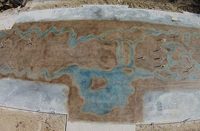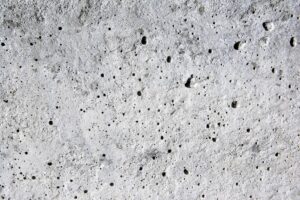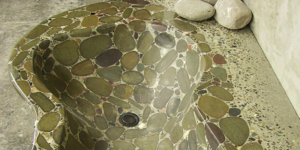I talk daily with concrete polishers from across the continent, and along with seeing their commitment and passion for the polishing business, I hear about their frustration with low compensation. Prices are dropping, and quality is going down proportionately. Rock-bottom prices are causing some of the best polishers to leave the business. Even with the “greatest floor on earth” as our product, many polishers have folded under economic pressures. How can we save the highly skilled artisans of this industry? How can we polish concrete profitably in this low-price environment? Is it really necessary to drop our prices for this skilled work? I believe that the answer to this last question is categorically NO.
The weak economy does not have to make our industry buckle under price pressures. We’ve forgotten that polished concrete is already the best bargain in the flooring industry, and what’s more, we’ve allowed the formulaic installation to become entrenched in specifications.
On top of all that, instead of educating our clients in the benefits of our product, we’ve allowed ourselves to be compared to low-end epoxy flooring, which does not require a skilled artisan and can be installed by following simple procedures. The client’s question has become simply, “Which costs less to install, polished concrete, an epoxy floor or other low-cost options?”
Too often, our response is to cut corners to deliver the most inexpensive floor in the shortest time, when our answer should be that the “big job” or the “quality job” will take longer. With a limited number of expert craftsmen, we can produce a certain amount of square footage per day, just like a master carpenter would of fine cabinetry.
Also, when our clients recognize quality and respect our trade as a skilled craft instead of as a simple “recipe” installation, then the profits will follow. Polished concrete is the original high-performance, durable, low-maintenance, decorative, functional, LEED-compliant, low-life-cycle-cost floor, and only skilled craftsmen are positioned to deliver.
Concrete polishing is truly an artisan craft, not simply a formulaic procedure. Becoming a master concrete polishing craftsman requires years of experience. We have not been clear about the value of this experience, and so our customers dictate that our prices and timelines must drop below profitability. We’ve responded by hiring untrained hourly workers to push substandard equipment in the “recipe” approach, resulting in garden-variety floors that fail to perform.
Professional training and skill
Professional polishing requires extensive training in concrete characteristics, nuances and conditions. It involves paying attention to how the machine sounds, vibrates and moves. Awareness of techniques such as looking behind the machine to evaluate whether the diamonds are cutting a complete scratch pattern, determining whether diamonds are glazed or not cutting, and recognizing an incorrect bond are keys to a quality floor. We must monitor how the hardness, flatness and finish level of the concrete affects the grinding. We must use sight, sound and touch to determine how the concrete is reacting to the diamonds, and we must decide how to prevent glazing, random scratches or other surface blemishes.
Advanced polishing skills are typically apparent after a minimum of two years of training and development. At that point, the polishing operator will understand what the concrete is telling him and will discern which diamonds, chemicals or methods to use next in order to produce a high-quality, scratch-free, durable, polished concrete floor. Experience makes the difference between a mediocre floor and the “greatest floor on earth,” and this experience is worth something.
In other artisan trades, more experience means higher pay. The distinction of higher quality goes with the titles of journeyman or master craftsman. Clients of artisans have been educated to know the difference, and this translates into compensation for the experience they have to offer. This is available to the professionals in our industry if we join together, regulate ourselves, and invest in educating our customers and staff. Several new concrete polishing conferences, associations and trade publications have started up within the last two years, offering hope that we can stop the decline in quality and be properly compensated for artisan installations.
Shortcuts lead to inferior results
What is wrong with charging the bare minimum and doing minimal work in the shortest possible time frame? Most low-cost, formulaic work is sold as a carbon-copy procedure, rather than the contractor specifying the result that will properly perform to the client’s expectations. For example, the contract may require only three diamond grits and one squirt of densifier to polish a floor in a compressed time frame. Important techniques such as complete densification and proper equipment operation are ignored in favor of barely acceptable practices. Then, we see big box-store floors receive minimal treatment and subpar polishing, and we hear that they “fail to perform.” This multifaceted “failure to perform” involves a cycle of staffing, densification and equipment shortcuts.
Improper densification can mean lightly misting the floor with densifier, not allowing enough time for the densifier silicates to chemically react, or using densifier at the wrong point in the process. Incomplete densification results in an inadequate wear surface without the proper durability. Failure to “feed the floor” for full densification will result in lost durability and shine, plus surface or color walk-off.
Substandard equipment does not allow the concrete to be opened properly and uniformly, so that the floor can then be densified and closed with proper diamond polishing. An example is the use of a swing machine or scrubber equipped with diamonds instead of a “real” diamond grinder.
Inadequate staffing and training mean that often the laborer is not a skilled, experienced artisan – he is just a person hired to push the machine.
These shortcut practices mean that polished concrete’s longevity and low-maintenance benefits cannot be delivered and will be perceived as false promises.
Restoring our reputation
Each time we fail to deliver a durable, low-maintenance floor, it whittles away at the aura and reputation of professionally polished concrete. This makes selling polished concrete even harder, and the expectation level of the customer drops further. When expectations drop, so do opportunities to be well compensated for our efforts. No longer is this the “greatest floor on earth” – instead, it is just one of many mediocre alternatives. Allowing our industry to be grouped into the category of “six months and then redo” concrete floors is simply unacceptable.
Inexperience, unskilled labor, substandard equipment, and tooling limitations cost money and time, and they can make a good job go bad. I once worked with a contractor on a 20,000-square-foot cookie-cutter job that stopped in its tracks because of equipment, tooling and training. The floor had deep scratches in one section, but the correct diamonds were not available for removing them, and a machine belt needed replacement before the equipment could be used. After an expensive one-week delay, the contractor received the right bond diamonds, repaired the equipment, and were able to blend the scratched area into the rest of the floor. If that operator had been attentively trained, he would have seen the scratches as they developed and ordered the correct diamonds immediately. With an educated operator, a spare parts kit and good diamond inventory, the costly delay could have been eliminated. Things are too easily overlooked when workers are told to hurry up and cut X square feet per hour by Y date and time, resulting in rushing the job. Shortcuts are taken and the quality suffers.
Finally, here are a couple of ways to avoid the garden-variety, low-cost, low-quality rut: No. 1: Install a paid mock-up on the actual job slab and keep it as a comparison until the job is complete. Determine upfront which diamonds will work most effectively and what steps are required to produce the expected clarity and shine. Explain that when the contract is signed and the job is completed, the mock-up cost will be credited back on the final invoice. Go in with your eyes open, plan properly and polish profitably.
No. 2: Educate the client about your company, the experience of your operators and the quality of the floors you install – not the intimate details of the diamond grits and procedures. Your client does not need to install the floor! Offer them the certainty of your experience and your results without raising worrisome questions about the details of the craft. No. 3: Let’s concentrate on producing high-quality, high-performance polished concrete floors under a pricing structure that allows us to make a profit. We’ll be proud of our craftsmanship and our expertise will be valued, allowing cookie-cutter, one-size-fits-all thinking to become a thing of the past.















